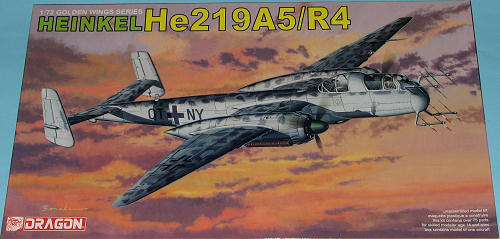
Dragon 1/72 He-219A-5/R4
| KIT: | Dragon 1/72 He-219A-5/R4 |
| KIT #: | 5041 |
| PRICE: | @$27.00 MSRP |
| DECALS: | Two Options |
| REVIEWER: | Scott Van Aken |
| NOTES: | New variant of an old favorite |

| HISTORY |
The Heinkel He 219 Uhu (Eagle-Owl) was a night fighter serving in the later stages of World War II with the German Luftwaffe. The requirement for an advanced night fighter was issued in 1942 and the He 219 was the product of this program. A relatively sophisticated aircraft, some speculate that had the Uhu been available in quantity it may have had a significant effect upon the strategic bomber offensive of the Royal Air Force. However very few of the aircraft saw service and the He 219 had no appreciable impact upon the course of the war.
The He 219 had an auspicious combat debut. On the night of 11-12 June 1943, Werner Streib flew the V9 and shot down five bombers. In the next ten days the three Heinkels He 219A-0 pre-production aircraft would shoot down a total of 20 RAF aircraft, including six of the previously "untouchable" de Havilland Mosquito fighter/bombers. Greatly encouraged, Kammhuber continued to press for immediate production.
Production finally got underway with the He 219 A-2 model which included a longer engine nacelle containing an extra fuel tank and typically included the R1 kit with two MK 108 30 mm cannons installed as Schräge Musik. Production problems due to allied bombing meant the A-2/R1 did not reach Luftwaffe units until October 1943. The first 10 to 15 aircraft were delivered with the FuG 212 (Lichtenstein C-1) 490 MHz UHF frequency radar.
Milch repeatedly tried to have the program killed and in the process Kammhuber was removed from office. Production ceased for a time but then restarted because the new Junkers Ju 388s were taking too long to get into service. Only 206 He 219s had been produced in the previous 15 months. Soon the A-5 began production and was the first major production variant He 219 to enter production. The A-5 featured an updated, 90 MHz VHF frequency Telefunken FuG 220 Lichtenstein SN-2 radar system which had a reduced range from the C-1 but was less vulnerable to chaff jamming and improved its accuracy and resolution.
The He 219 was a capable fighter aircraft, allowing the pilots a large degree of autonomy. Ground control simply got them into the right area and then the pilots took over and hunted down the bombers on their own – the SN-2 radar's 4 km range was longer than the distance between the bombers. The performance of the A-5 was not extraordinary – about 580 km/h or 360 mph – but it was enough of an advance over the Messerschmitt Bf 110s and Junkers Ju 88Gs that the aircraft could chase several bombers per sortie.
At lest one aircraft is still extant, in storage with the Smithsonian collection.
| THE KIT |
 Back
in the old DML days, Dragon produced a number of He-219 variants. This was not
one of them. This particular aircraft carried a third member as a rear gunner.
The reference somewhat contradicts itself in commenting in the variants section
that this version only had a few prototypes actually built, though the main
write-up states it was a main production airframe. It seems that it was a major
production version, with the /R4 version adding the rear gunner. This version
did see limited use during 1945.
Back
in the old DML days, Dragon produced a number of He-219 variants. This was not
one of them. This particular aircraft carried a third member as a rear gunner.
The reference somewhat contradicts itself in commenting in the variants section
that this version only had a few prototypes actually built, though the main
write-up states it was a main production airframe. It seems that it was a major
production version, with the /R4 version adding the rear gunner. This version
did see limited use during 1945.
The kit will be an old favorite with some. It has a very nicely done cockpit and radar operator's position. An additional small sprue is added for the rear gunner. The builder will be challenged to find room for nose weight on this one as it will be a major tail sitter without it. The central lower fuselage is open to allow Dragon to provide different variations on the belly gun pack. The kit uses photo etch for the radar antennas, main instrument panel and lower radio antennas as well as the DF antenna bits. A brand new canopy is provided to take in the gunner's position. It is a single piece and is quite well molded.
A complex kit this is not as 8 construction steps will take care of the 75 pieces. Color info with Gunze and Model Master paint is provided. Two markings options are given, both with NJG 3 in 1945. Both are a base of RLM 76, and both have upper surface mottling of various sizes in what is probably RLM 74, but no upper color information is provided! On one plane, the underside is matte black. Decals are nicely done, but minimal with codes, crosses and serials.
| CONCLUSIONS |
It is nice to see Dragon reissuing these kits in different variations. I know this is a popular modeling subject and now there is an additional variant to add to the collection. Like other Dragon aircraft kits, it will take careful construction, but the results will be well worth the effort.
| REFERENCES |
June 2008
My thanks to www.dragonmodelsusa.com for the review kit. Get yours at your favorite shop or ask them to order it for you.
If you would like your product reviewed fairly and quickly, please contact me or see other details in the Note to Contributors.